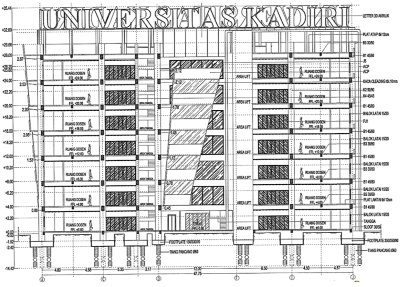Comparative Analysis of As Built Drawings with Implementation Results at the Kadiri University Construction Field
DOI:
https://doi.org/10.24036/cived.v11i1.564Keywords:
As Built Drawing, Comparison of Construction Standards, 3D Modeling Technology, Plan Analysis, EfficiencyAbstract
Comparative analysis of as-built drawings with construction company standards shows that the as-built drawings made meet most of the expected characteristics and parameters. This illustrates that 3D modeling technology, especially using Autodesk software, can provide accurate and reliable results. This as-built drawing can be used as a good reference for analyzing differences between initial plans and implementation in the field. Although there are some limitations in the information that can be displayed, this as-built drawing can provide a general idea of the structure and dimensions of the building. Thus, it can help in identifying potential errors or discrepancies between drawings and actual implementation. This research contributes to increasing efficiency, quality and safety in the building construction process. By using 3D modeling technology and analyzing as-built drawings, researchers can identify potential differences and provide recommendations for improvements or design changes to minimize risks and ensure good quality of the final result. This research also provides insight into the development of standards or guidelines for making as-built drawings in the construction industry. Based on the analysis of the level of conformity of the project results in the field with the as-built drawings for building construction, the quality of the as-built drawings has good geometric accuracy as indicated by an RMSE of 1.9 cm and a standard deviation of 1.4 cm, which means it falls into the appropriate mm-cm fraction. with image validation criteria. As built drawings also meet all drawing validation criteria. Apart from that, the as-built drawing meets all the parameters in the characteristic criteria for the as-built drawing model.
Downloads
References
S. P. Silma, L. Widaningsih, en A. Ardiansyah, “The measurement of specific life skill based on National Qualification Competency Certification Scheme in the field of Building Construction Drawing”, IOP Conf. Ser. Mater. Sci. Eng., vol 830, no 4, 2020, doi: 10.1088/1757-899X/830/4/042078.
S. G. Jian Zuo, Xianbo Zhao, Quan Bui Minh Nguyen, Tony Ma, “Soft skills of construction project management professionals and project success factors: Engineering, Construction and Architectural Management Soft skills of construction project management professi”, Eng. Constr. Archit. Manag., vol 25, no 3, bll 425–442, 2018, [Online]. Available at: https://doi.org/10.1108/ECAM-01-2016-0016
G. Guven et al., “A construction classification system database for understanding resource use in building construction”, Sci. Data, vol 9, no 1, bll 1–12, 2022, doi: 10.1038/s41597-022-01141-8.
L. Li, L. Wang, en X. Zhang, “Technology Innovation for Sustainability in the Building Construction Industry: An Analysis of Patents from the Yangtze River Delta, China”, Buildings, vol 12, no 12, 2022, doi: 10.3390/buildings12122205.
V. Ciotta, D. Asprone, G. Manfredi, en E. Cosenza, “Building Information Modelling in Structural Engineering: A Qualitative Literature Review”, CivilEng, vol 2, no 3, bll 765–793, 2021, doi: 10.3390/civileng2030042.
C. M. Yeum, A. Lund, S. J. Dyke, en J. Ramirez, “Automated Recovery of Structural Drawing Images Collected from Postdisaster Reconnaissance”, J. Comput. Civ. Eng., vol 33, no 1, bll 1–11, 2019, doi: 10.1061/(asce)cp.1943-5487.0000798.
R. Sacks en R. Barak, “Teaching building information modeling as an integral part of freshman year civil engineering education”, J. Prof. Issues Eng. Educ. Pract., vol 136, no 1, bll 30–38, 2010, doi: 10.1061/(ASCE)EI.1943-5541.0000003.
S. Maree, F. E. Rotimi, en J. O. B. Rotimi, “The primacy of as-built drawings in the management of underground utility operations: A New Zealand study”, Buildings, vol 11, no 9, bll 1–14, 2021, doi: 10.3390/buildings11090399.
P. Gholizadeh, B. Esmaeili, en P. Goodrum, “Diffusion of Building Information Modeling Functions in the Construction Industry”, J. Manag. Eng., vol 34, no 2, 2018, doi: 10.1061/(asce)me.1943-5479.0000589.
Y. H. Ahn, Y. H. Kwak, en S. J. Suk, “Contractors’ Transformation Strategies for Adopting Building Information Modeling”, J. Manag. Eng., vol 32, no 1, 2016, doi: 10.1061/(asce)me.1943-5479.0000390.

Downloads
Published
Issue
Section
License
Copyright (c) 2024 Imam Mustofa, Eko Siswanto, Sigit Winarto

This work is licensed under a Creative Commons Attribution 4.0 International License.

